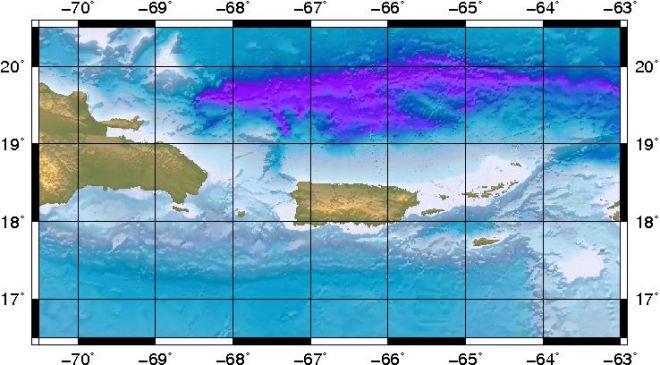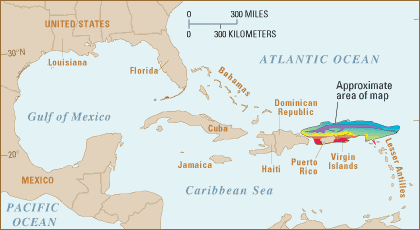Earthquake Activity In The Puerto Rico Trench 06-12 October 2011
A series of earthquakes have been recorded along the Puerto Rico Trench, near the the British/U.S. Virgin Islands and Puerto Rico, during the past week.
30 earthquakes, ranging in magnitude from 2.7 to 3.5, have been recorded in the region, according to the United States Geological Survey (U.S.G.S.). The majority of the tremors occurred to the north of the Virgin Islands and to the northwest of Puerto Rico.
None of the islands have active volcanoes but earthquakes exceeding 7 magnitude on the Richter Scale have occurred in the region during the last 100 years (see below).
Puerto Rico, the United States Virgin Islands, British Virgin Islands, and the Dominican Republic do not have active volcanoes; however, they are at risk from earthquakes and tsunamis. The Puerto Rico Trench is capable of producing earthquakes greater than magnitude 8.0.
An earthquake measuring 4.6MI on the Richter scale was felt throughout Puerto Rico and the Virgin Islands on the afternoon of 27 September, 2011. The epicenter was located 5km (3 miles) northwest from The Settlement Anegada at a depth of 41.9km. A magnitude 4.7 earthquake, the strongest to hit the Puerto Rican region this year, was recorded on 21 May. It was recorded 118 km east of Higüey, according to the EMSC.
The islands are located along the Puerto Rico Trench, an oceanic trench located on the boundary between the Caribbean Sea and the Atlantic Ocean. The trench is associated with a complex transition between the subduction zone to the south along the Lesser Antilles island arc and the major transform fault zone or plate boundary that extends west between Cuba and Hispaniola through the Cayman Trench to the coast of Central America.
The island of Puerto Rico lies immediately to the south of the fault zone and the trench. The trench is 800 kilometres (497 mi) long and has a maximum depth of 8,000 metres (26,247 ft) at Milwaukee Deep, which is the deepest point in the Atlantic Ocean and the deepest point not in the Pacific Ocean.


Scientific studies by the National Oceanic and Atmospheric Administration (NOAA) have found that an earthquake occurring along this fault zone could generate a significant tsunami. NOAA stated: “A large fault system, which is similar to the San Andreas Fault in California, was discovered in very deep water near the trench. Much of the horizontal sliding between the North American and Caribbean plates occurs along this fault. The fault was named after Dr. Elizabeth (Betty) Bunce, a marine geophysicist pioneer who investigated this challenging environment in the 1950s.”
Since 1988, the Puerto Rican Seismic Society has been using the Puerto Rican media to inform people about a future earthquake.
Puerto Rico Trench Earthquake/Tsunami History

On 11 October 1918, the western coast of the island was hit by a major earthquake (7.5 magnitude), which produced a tsunami. In 1953, Santo Domingo, Dominican Republic, was affected by the Santo Domingo earthquake. The 1918 earthquake was caused by an old left-lateral strike-slip fault near the Mona passage. The actual subduction zone (Puerto Rico Trench) hasn’t ruptured in over 200 years.
Puerto Rico in particular has always been an area of concern to earthquake experts because, apart from the 1918 episode, there are frequent cases of tremors in and around the island. A 1981 tremor was felt across the island, while another in 1985 was felt in the towns of Cayey and Salinas.
Other significant earthquakes in the region:
1787 – Anegada Trough: 8.1m
1867 – Mona Canyon: 7.5m
1946 – Mona Canyon: 7.5m
1946 – Dominican Republic: 8.1
1953 – Dominican Republic: 6.9
During 2010 the Puerto Rico Seismic Network (PRSN) located 1681 tremors, 1058 less than previous year, 2010. 68 earthquakes were reported as felt. The magnitudes calculated by the PRSN during 2010 ranged from 0.5 to 5.70. Depths were distributed between 0.3 to 200.7 km, while for felt earthquakes depths ranged from 0.2 to 159.1 km.


